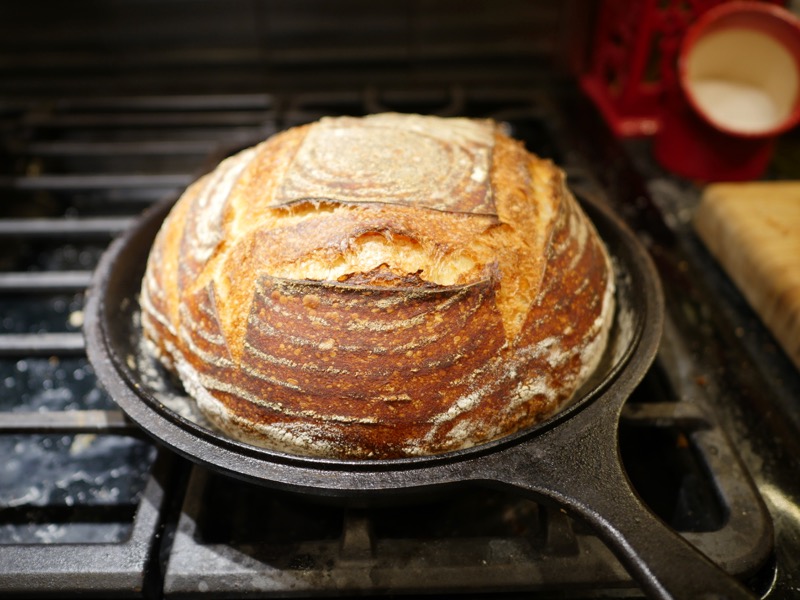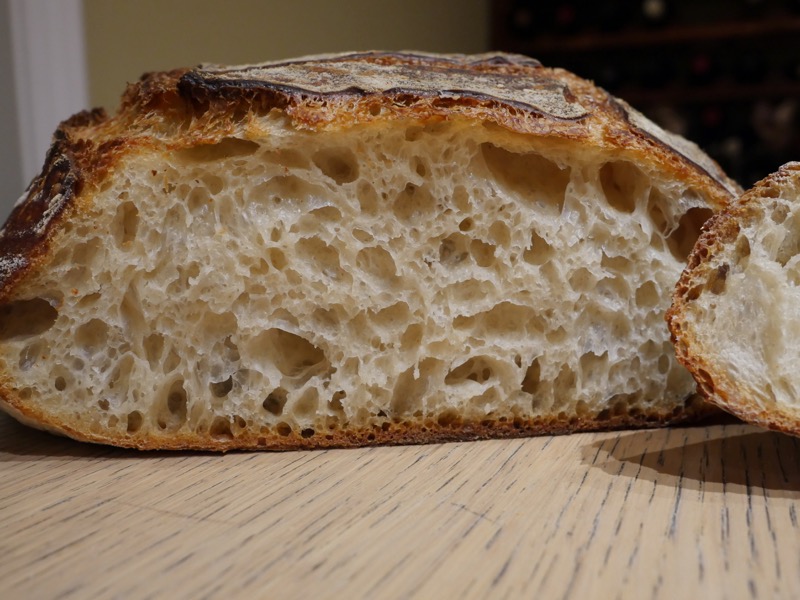
As I said in my introductory post, I'm attempting to marry the flavor of my early no-knead loaves with the shape and form of my more recent, well-risen loaves. My early loaves were definitely not very photo-worthy, but they tasted good. And my recent loaves are generally pretty attractive, but are definitely lacking in taste.
My standard recipe is a pretty basic sourdough -- 68% hydration, 30% starter, 2.5% salt.
Until very recently (i.e. the last few days) I've been doing shortish bulk rises while building the dough (approximately three hours with turns at every 30 minutes) followed by shaping and a very long proof -- overnight at room temperature, albeit in a fairly cool room (mid-60s, of late). This approach has worked wonders for my bread shape, with some of the loaves actually pushing against the insides of the pan and flattening on top. Certainly better looking than my earlier attempts.
I'm now branching out a bit in order to try to improve the taste. With cool weather upon us, I decided I would start experimenting with a very long bulk rise to go with my very long proofing, and have cut way back on the starter to compensate. I pushed one loaf up to about 40 hours total (bulk + proofing), but have settled on 24 hours as it fits into my schedule really well. I still do two-three hours of 30-minute turns, but then let it sit for 10 hours overnight, shape it in the morning, and then let it proof all day while I'm at work.
So far, I'm liking the direction it's headed. I'm still getting well-risen loaves, and my latest attempt (the one shown here cut open) was moist (but not too moist) and very tasty. I don't usually push the loaf this dark, either, but the crust on the one without sesames was amazing and had some of that shatter-in-your-mouth quality that I've only achieved accidentally before.
Next, I'm going to try higher hydration. I've really hated handling high-hydration dough in the past, and made a right mess of things on more than one occasion. My dough handling skills are a little better now, though, and I don't fear the sticky dough quite as much as I used to. That said, I've been using sesame seeds as a defense mechanism on almost every loaf I've made for the last year, to keep it from sticking to the banneton and ending up in a disaster at bake time. This was the first loaf in as long as I can remember that I was brave enough to bake naked, and it came out pretty well.


How much starter are you now using with the extended bulk fermentation?
I started out at 10% starter for my first 40-hour attempt, and then bumped it up to 15% for my subsequent attempts, which brought the rise times roughly within 24 hours.
What lovely looking breads you have there. Looks delicious.
Have you heard of the "Do Nothing Bread"?
You can play around with the hydration but it should be high for a no knead bread to work. If all bread flour you can go as low as 75% hydration but with a mix of wholegrain and bread flours you can go to 90% hydration. So either...
Bread Flour 100%
Water 75%
Salt 2%
Starter 1%
Or...
Flour 100% (60% whole-wheat, 40% bread flour)
Water 90%
Salt 2%
Starter 1%
You can play around with the flour and hydration (but not too low as it is no knead) but the starter should be in the 1% range.
You mix the dough and bulk ferment for 24 hours with one set of stretch and folds at around the midway mark. That's it!
After 24 hours shape (this doesn't have to be done too strictly as it'll be more ciabatta style dough you'll find) and final proof for one hour. Bake in pre-heated oven.
The aim of this bread from bulk ferment to shaping is it wants as little inference as possible. It's left pretty much alone for nature to do most of the work.
Look up Yohan Ferrant's "do nothing bread" on google.
I had not heard of "do nothing bread" until just now, thanks. I went and read about it, and it does sound interesting. Not unlike the no-knead approach that I had used at the beginning of my bread-baking career. I'll try this approach as an experiment, just for completeness. My version of no-knead came from Ben Starr's recipe (it was kind of an accident that I stumbled on that recipe while looking for something else entirely) and if I've done my math correctly, it's only 68.5% hydration -- so perhaps not a "true" no-knead bread.
That said, I'm not after the ease of no-knead so much as the flavor. I'm not averse to building some strength into the dough, and in fact very much want a well-risen loaf that also happens to taste great. I keep coming back to the long ferment times of no-knead as the likely source of the flavor profile.
I have a batch of dough rising right now where I've used 75% hydration / 15% starter / 2.5% salt. I'll be interested to see how it differs.
I think you're on the right track, that longer ferment times add to the flavour profile (to a point), as this gives resident yeasts and bacteria more time to work on the dough (until they run out of food). Your latest bread looks fantastic, with a lovely crust and crumb, which leads me to ask - why do you want to now up the hydration? I can't see how adding more water will add anything to the flavour. :)
Exploration, really. I can look at pictures of lovely loaves all day, but I have no idea what anything tastes like. Having become reasonably good at producing well-risen loaves, I want to vary some obvious variables and determine for myself what impact those changes have on flavor and texture.
And it's very good of you to share all this exploration with this forum, so we can all learn together! There are so many variables in bread baking that it's difficult to have the discipline to vary only one at a time and then record the results. So many breads, so little time... :)
Most people do not like sour bread so a less sour sourdough bread would mean better flavor for most folks. For me it is just the opposite and a less sour sourdough to me is bland bread. Most people like white bread the best, but for me, whole sprouted grains are the way to go for more flavor and better tasting bread.
No matter what your flavor standard is there are techniques to get you there when it comes to sourdough bread.
Your latest atemot looks nice. but you are right, it has to taste great to be a success.
Happy baking
I agree. I like more sour in my sourdough. I'll probably explore other flours and grains in the future as well, once I get a handle on a basic sourdough loaf. I've dabbled in 100% spelt loaves already, and they add an interesting flavor dimension, though I have yet to master getting them well-risen.
The most important thing for me in making sour is using whole grains. The bran acts as buffer allowing LAB to continue to reproduce and make more acid at lower pH's than they normally could.
The 2nd most important thing is high temperatures, 90-92 F for counter work like starter and levain builds, gluten development and final proofing.
Number 3 is cold temperatures for a very,verylong time for starters - weeks, as long as possible for levains 2-3 days and bulk ferments - 24 hours.
Number 4 is hydration. Less hydration with low temperatures promoted acetic acid production over longer times in startetrs adn kevains. LAB live high hydration dough though.
A SD culture can have 10 to 1 LAB to yeast ratio - less sour or 100 to 1 LAB to yeast ratios - sour. The above promotes LAB reproduction rates while restricting yeast reproduction rates which leads to a starter, levain and dough that has higher LAB to yeast ratios which means each can produce more acid than those that have less LAB in them.
Temperature and hydration also can promote the two kinds of acid that LAB produce, Lactic acid - the normal acid that provides sour and acetic acid the 'tang' in SD. A balance in both is what makes for good SD bread in my book as does a more sour taste in general.
But this is completely personal and most people by far prefer bread that is not sour or less sour when sourdough is in the mix. Luckily, we know the science well enough today to make what ever kind of sourdough bread we personally like just by manipulating all of the above at the right time, for the right length of time. But that is not all.
It is just science and the kind of wee beasties you have in your culture. Some wee beasties can produce as much CO2 as yeast and some can be prompted to produce CO2 and ethanol and little acid just like yeast do. Some produce more acid than others some don't produce much acetic acid and others a lot of it. So, you can change your sour and tang profile by using a different culture without changing anything else in the method.
See No Muss No Fuss Starter on this site for making your starter more sour and having a greater LAB to yeast ratio.
Happy sour baking
Thanks for that info. These are details that I was only dimly aware of, if at all. That'll help me zero in on my ideal loaf.
Well done :)
I would be happy if my loaves would be looking so when I started to bake with sourdough.
Well done and happy baking, Joze